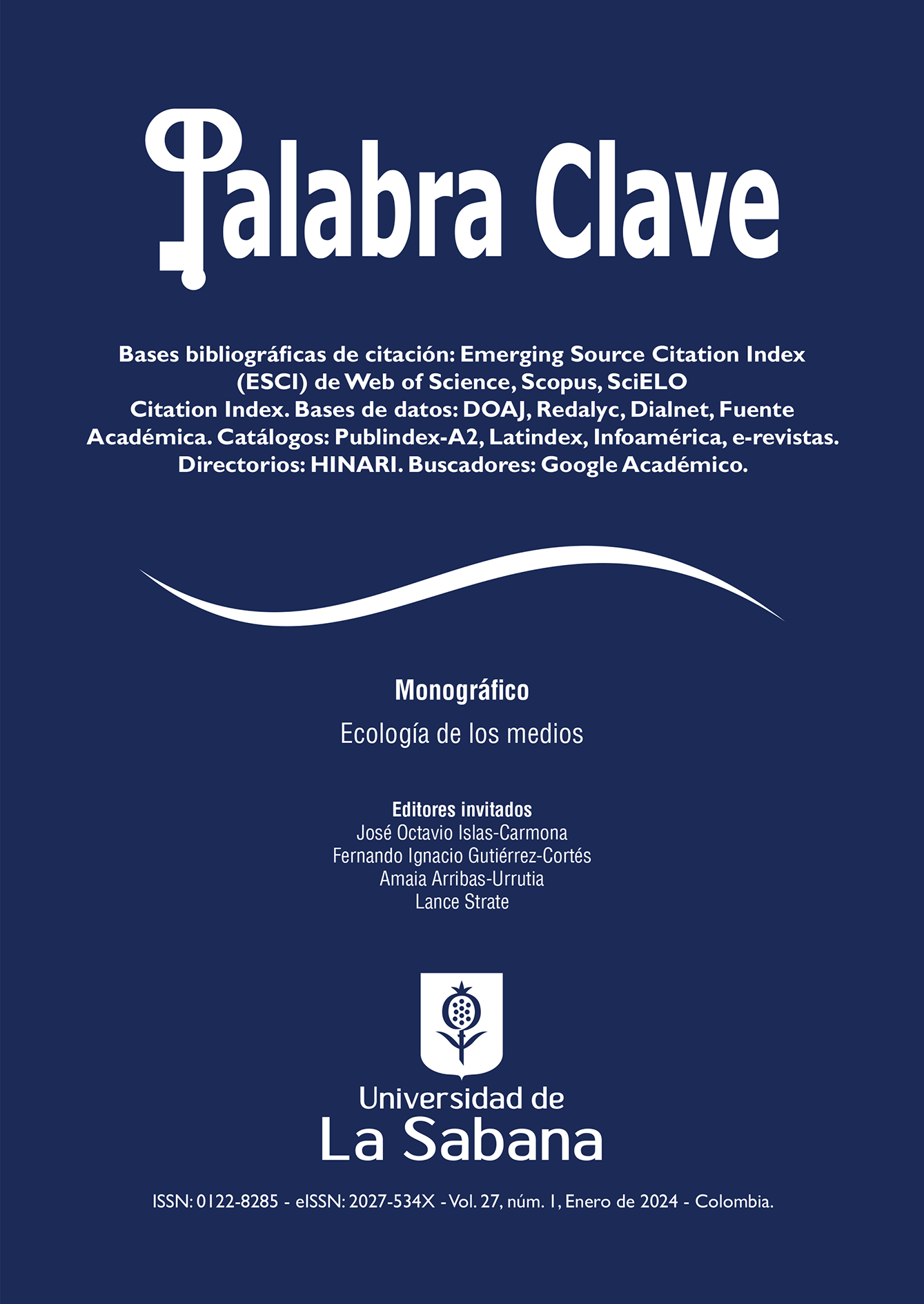La ecología de medios: un ambiente y un territorio complejos por reconocer
DOI:
https://doi.org/10.5294/pacla.2024.27.1.1Palabras clave:
Comunicología, ecología de medios, inteligencia artificial, Marshall McLuhan, mensaje, tecnologíasResumen
La ecología de medios (Media Ecology) es el tema central del volumen 27, número 1, de la revista científica Palabra Clave, el cual comprende diez textos. En la presentación del número abordamos la ecología de los medios como metadisciplina compleja que de ninguna manera puede ser encorsetada en el imaginario de la comunicología y destacamos la extensión y amplitud de su objeto de estudio, que comprende desde las primeras tecnologías desplegadas por el Homo Sapiens hasta la inteligencia artificial.
Descargas
Citas
Boorstin, D. J. (1978). The image: A guide to pseudo-events in America. Atheneum.
Carpenter, E. (1973). Oh, what a blow that phantom gave me! Holt, Rinehart & Winston.
Eisenstein, E. L. (1979). The printing press as an agent of change (2 vols.). Cambridge University Press.
Ellul, J. (1964). The technological society (trad. J. Wilkinson). Knopf.
Innis, H. A. (1951). The bias of communication. University of Toronto Press.
Korzybski, A. (1993). Science and sanity: An introduction to non-Aristotelian Library. Institute of General Semantics.
McLuhan, M. (1962). The Gutenberg Galaxy: The making of typographic man. Toronto University Press.
McLuhan, M. (1964). Understanding Media: The extensions of man. Routledge.
McLuhan, M. y Fiore, Q. (1967). The medium is the massage: An inventory of effects. Penguin Classics.
McLuhan M. y McLuhan E. (1988). Laws of media: The new science. Toronto University Press.
Mumford, L. (1934). Technics and civilization. Harcourt Brace.
Mumford, L. (1967). The myth of the machine. I. Technics and human development. Harcourt Brace and World.
Mumford, L. (1970). The myth of the machine. II. The pentagon of power. Harcourt Brace Jovanovich.
Nystrom, C. (1973). Towards a science of media ecology. Doctoral Dissertation, New York University.
Nystrom, C. (2021). The genes of culture: Towards a theory of symbols, meaning, and media (vol. 1). Peter Lang.
Ong, W. J. (1982). Orality and literacy. Methuen.
Platón (1973). Phaedrus and Letters VII and VIII (trad. W. Hamilton). Penguin.
Postman, N. (1968). Growing up relevant. Address delivered at the 58th annual convention of the National Council of Teachers of English, Milwaukee, WI, November 29.
Postman, N. (1970). The reformed English curriculum. In Eurich, A. C. & the Staff of the Academy for Educational Development (Eds.), High School 1980: The shape of the future in American secondary education. Pitman.
Postman, N. (1985). Amusing ourselves to death. Viking.
Postman, N. (1992). Technopoly: The surrender of culture to technology. Alfred A. Knopf.
Schmandt-Besserat, D. (1996). How writing came about. University of Texas Press.
Sontag, S. (1977). On photography. Farrar, Straus & Giroux.
Strate, L. (2017). Media ecology: An approach to understanding the human condition. Peter Lang.
Strate, L. (2022). Concerning communication: Epic quests and lyric excursions within the human lifeworld. Institute of General Semantics.
Susskind, L. (2007). El paisaje cósmico: Teoría de las cuerdas y el mito del diseño inteligente. Drakontos.
Publicado
Cómo citar
Número
Sección
Licencia
Derechos de autor 2024 Octavio Islas-Carmona, Fernando Ignacio Gutiérrez-Cortés, Amaia Arribas-Urrutia, Lance Strate

Esta obra está bajo una licencia internacional Creative Commons Atribución 4.0.
Esta revista y sus artículos se publican bajo la licencia CreativeCommons CC BY 4.0 DEED Atribución 4.0 Internacional, usted es libre de: Compartir — copiar y redistribuir el material en cualquier medio o formato para cualquier propósito, incluso comercialmente. Adaptar — remezclar, transformar y construir a partir del material para cualquier propósito, incluso comercialmente. La licencia no puede revocar estas libertades en tanto usted siga los términos de la licencia.









